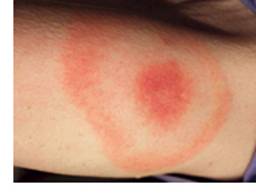Preventing Lyme Disease
Sponsored by:

Preventing Lyme Disease
Tip content provided by: WebMD.com
For thermographers who work outdoors, exposure to Lyme disease can pose a significant health hazard. In this Tip, we discuss this serious disease, its symptoms, and ways to help prevent it.
What Is Lyme Disease?
Lyme disease is a serious infection transmitted to humans and other mammals via the bite of deer ticks that are infected with the spirochete bacteria, Borrelia burgdorferi. The animals that most often carry these insects are white-footed field mice, deer, raccoons, opossums, skunks, weasels, foxes, shrews, moles, chipmunks, squirrels, and horses. Lyme disease is not contagious between persons.
Where Is Lyme Disease Found?
Lyme disease has been reported in nearly all states in the United States, although most cases are concentrated in the coastal northeast, Mid-Atlantic States, Wisconsin, Minnesota, and northern California. Lyme disease is also found in large areas of Asia and Europe.
What Are the Symptoms of Lyme Disease?
In the early stages of Lyme disease, you may experience flu-like symptoms that can include a stiff neck, chills, fever, swollen lymph nodes, headaches, fatigue, muscle aches, and joint pain. You also may experience a large, expanding skin rash around the area of the tick bite. In more advanced disease, nerve problems and arthritis, especially in the knees, may occur.

of Lyme Disease.
How Is Lyme Disease Diagnosed?
The easiest way for a doctor to diagnose Lyme disease is to see the unique bull’s-eye rash. If there is no visible rash (as is the case in about one-fourth of those infected), the doctor might order a blood test three to four weeks after the onset of the suspected infection to look for antibodies against the bacteria.
How Is Lyme Disease Treated?
In its early stages, Lyme disease can be effectively treated with oral antibiotics. In general, the sooner such therapy is begun following infection, the quicker and more complete the recovery. For advanced cases, intravenous antibiotics may be necessary.
How Can I Prevent Getting Lyme Disease?
Essential to prevention is the avoidance of deer ticks. Although generally only about one percent of all deer ticks are infected with the Lyme disease bacterium, in some areas more than half of them harbor the microbe. Deer ticks are most often found in wooded areas and nearby grasslands, and are especially common where the two areas merge.
Try these tips to prevent tick bites when working in tick prone areas:
1. Wear long sleeves and light colored clothing in order that ticks can be seen more easily
2. Wear your shirt tucked into your pants, and your pants tucked into your socks or boots.
3. Apply tick repellents with DEET to your clothing, shoes and socks before going out.
4. Check yourself, family, and your pets routinely for ticks, especially after a trip outdoors.
5. Shower and shampoo your hair if you think you may have been exposed to ticks.
6. Check your clothes for ticks and wash them immediately in order to remove any ticks.

